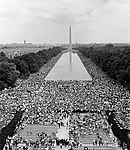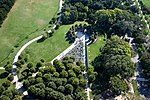I Have a Dream

"I Have a Dream" is a public speech that was delivered by American civil rights activist and Baptist minister, Martin Luther King Jr., during the March on Washington for Jobs and Freedom on August 28, 1963. In the speech, King called for civil and economic rights and an end to racism in the United States. Delivered to over 250,000 civil rights supporters from the steps of the Lincoln Memorial in Washington, D.C., the speech was a defining moment of the civil rights movement and among the most iconic speeches in American history.Beginning with a reference to the Emancipation Proclamation, which declared millions of slaves free in 1863, King said "one hundred years later, the Negro still is not free". Toward the end of the speech, King departed from his prepared text for a partly improvised peroration on the theme "I have a dream", prompted by Mahalia Jackson's cry: "Tell them about the dream, Martin!" In this part of the speech, which most excited the listeners and has now become its most famous, King described his dreams of freedom and equality arising from a land of slavery and hatred.Jon Meacham writes that, "With a single phrase, King joined Jefferson and Lincoln in the ranks of men who've shaped modern America". The speech was ranked the top American speech of the 20th century in a 1999 poll of scholars of public address. The speech has also been described as having "a strong claim to be the greatest in the English language of all time".
Excerpt from the Wikipedia article I Have a Dream (License: CC BY-SA 3.0, Authors, Images).I Have a Dream
Lincoln Steps, Washington
Geographical coordinates (GPS) Address Website Nearby Places Show on map
Geographical coordinates (GPS)
| Latitude | Longitude |
|---|---|
| N 38.889277777778 ° | E -77.050138888889 ° |
Address
Lincoln Memorial
Lincoln Steps
20418 Washington
District of Columbia, United States
Open on Google Maps









